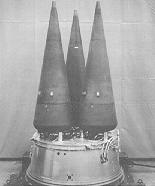Multiple Independently Targetable Reentry Vehicles (MIRVs)

Document one:"MIRV: A BRIEF HISTORY OF MINUTEMAN and MULTIPLE REENTRY VEHICLES" by Daniel Buchonnet, Lawrence Livermore Laboratory, February 1976
Released through FOIA request to Defense Department, June 1997
At the request of the National Security Archive, the Department of Defense has released the only known classified history of multiple independently targetable reentry vehicles [MIRV]. This heavily excised document reflects a declassification review by both the Department of Defense and the Department of Energy. Due to the numerous redactions, some of which appear to be unjustifiable, the Archive has requested the Energy Department (which has the principal equity in this document) to determine whether additional portions may be released.
This document confirms much of what has been known about the basic purposes of the MIRV but provides additional valuable detail1. Among the findings:
The version of "MIRV" which appears here does not include the appendix with notes, which is even more heavily excised. Apparently, the Department of Energy will be putting the complete document on "Opennet." The Archive will create a link between this document and the full version as soon as possible.An anticipated benefit of MIRVs was that they would permit the "enhancement of a first-strike capability" for U.S. strategic forces (p. 12). According to the study, "the issue of first strike capability was raised and widely discussed" (p. 9). That is, by increasing the numbers of warheads per missile, whether land or sea-based, MIRVs would put the United States in a better position to penetrate Soviet defenses and simultaneously strike diverse targets, especially Soviet missile and air bases. The idea of multiple warheads dates back to the mid-1960s, but the key year in the history of the MIRV concept was 1962 when several of technological developments made it possible for scientists and engineers to conceive of multiple, separately targeted warheads that could hit a growing list of Soviet nuclear threat targets. One important innovation was that the weapons laboratories had designed small thermonuclear weapons, a necessary condition for deploying multiple reentry vehicles on the relatively small Minuteman. Equally significant were the ABLE-STAR and TRANSTAGE space vehicles which made it possible to place several space satellites on different orbits. Those vehicles were the "direct predecessors" of the MIRV "bus" used to propel the reentry vehicles to target. A major event in MIRV history was a decision in 1966 to enlarge the Minuteman's third stage, thus creating Minuteman III (pages 19 and 43). This made it feasible to deploy MIRVs on the Minuteman because earlier versions had a relatively small throw- weight (payload) which limited the size of the weapons package and supporting equipment. MIRV would be used to reduce collateral damage "by matching the yield to the target." MIRVs could hit point targets, such as a missile base or silo, so accurately that only a small nuclear warhead would be necessary to achieve the anticipated destruction. Collateral damage, therefore, would be less compared to that caused by larger, enormously destructive thermonuclear warheads. The yield of the Minuteman III MIRV is excised from this document but as of the early 1970s it approximated 170 kilotons, substantially less than the Minuteman I's 1.2 megaton yield. (Nevertheless, one Minuteman MIRV warhead would have had over eight times the yield of the 20 kiloton weapon dropped on Hiroshima, thus, collateral damage would still be extensive). While some proponents of MIRVs argued that they would have a "stabilizing effect" on the U.S.-Soviet balance of power, the author acknowledges that they "probably contributed to an escalation of the arms race" to the extent that the Soviets perceived the "U.S. MIRV systems ... as strengthening the U.S. counterforce capability (high accuracy of low yields) and improving the first-strike capability (large number of warheads" (p. 6)
1See political scientist Ted Greenwood's significant study, Making of the MIRV: A Study of Defense Decision Making (Ballinger. 1975).